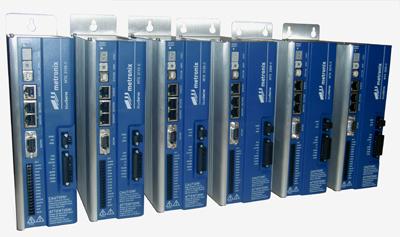
At SPS/IPC/DRIVES, Metronix announces a new range of servo motor drives that provide automation builders with an outstanding new combination of capability and economy. Called blueServo, the packaged drives combine a universal real-time Ethernet capability with safe torque off functional safety and comprehensive encoder interfacing capability — including the single-cable HIPERFACE DSL scheme. All of these features and more have been integrated thanks to a brand new hardware platform that has been designed-from-scratch to lower costs by around 25 percent.
"Downwards price pressure is here to stay and with this brand new drive family we began the design project with a goal of reducing hardware costs by approximately 25 percent compared with current European drive ranges," says Frank Essmann of Metronix. "We looked at the problem from all angles and as a result the new drives have some interesting features that help lower costs. Metronix is also known for its customization and private label capability, and this too was part of the specification — allowing us to offer exciting possibilities to OEMs with this technology."
Metronix will launch the new blueServo range with an initial choice of six packaged, panel-mounting single-phase and three-phase drives offering continuous output power ratings from 0.5 to 6 kVA. The hardware feature set chosen for the new drives is a combination of the most-commonly required features by Metronix's broad customer base, along with some brand new capability.
The use of real-time Ethernet communications protocols is a major trend in the industry and to meet this demand Metronix has embedded a universal Ethernet capability into the drive. It allows the drive to be used in automation systems employing EtherCAT, PROFINET, Sercos III or Ethernet/IP protocols for example, in addition to the commonly-used CANopen network interface.
A broad encoder interfacing capability is another major element of the servo drive family. Metronix blueServo drives allow connection to resolvers, analog/digital incremental encoders, and single/multiturn absolute encoders such as HIPERFACE or EnDat. The drives also support the digital HIPERFACE DSL interface — which allows automation engineers to cut system building costs substantially by using only a single cable connection between drive and motor.
Enhanced machine safety is another important trend, and Metronix has included support for Safe Torque Off (STO) functional safety in the new drives. This is designed to meet Category 4/PLe according to EN 13849-1 — the maximum rating achievable single-axis safety level in this category.
Further features include an integral line filter and brake resistors — a typical characteristic of Metronix drives — allowing blueServo to offer a standalone and ready-to-use solution for many common automation applications. A powerful and easy to use Windows-based software tool for parameterizing and analyzing the new drives is additionally available.
A key element of the new drive design is its low cost. This has been achieved by several factors. These include a carefully selected feature set that satisfies a large proportion of applications, and the implementation of these features directly in the embedded system rather than by means of more versatile, but more expensive techniques such as expansion slots — as used on some of Metronix's existing drive families. Metronix also increased the flexibility of the drive — without increasing costs — by partitioning the electronics design across two boards to reduce printed circuit layers and allow single-sided component mounting, and assembly/manufacture using simple processes. The two-board design serves to support Metronix's large custom drive business. One common request for example is to integrate an OEM's application-specific drive control electronics with Metronix's power stage — this is easily accommodated with the carefully-partitioned blueServo design.
"With blueServo we have created a drive that is designed and built to the most demanding professional standards, yet is also extremely price competitive," adds Frank Essmann. "We believe that machine and automation builders can rely on it to help make their future generations of equipment as price competitive as equipment sourced from any world region — including low-wage-cost economies."






